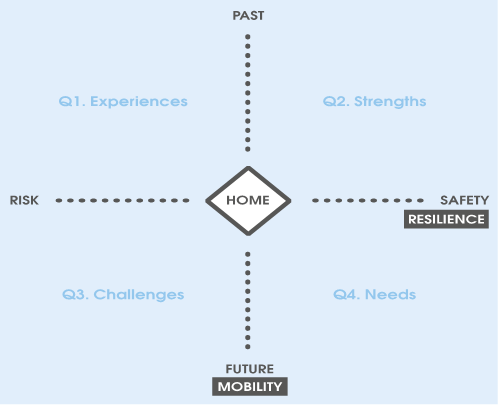Co-learning disaster resilience: A person-centred approach to engaging refugee narratives and practices of safety
Global displacement trends and recent calls to action, such as expressed in The New Urban Agenda 2016, the New York Declaration for Refugees and Migrants 2016, the Comprehensive Refugee Response Framework 2018 and the forthcoming Global Compact on Refugees 2018, underline the need for strengthening a whole-of-society approach for ensuring the safety of migrants, refugees and humanitarian entrants.
Yet, humanitarian and settlement programs do not systematically inform refugee and humanitarian entrants about personal safety and home preparedness for a range of local and natural hazards.
Commitments made in the Hyogo Framework for Disaster Risk Reduction 2005-2015 and succeeded by the Sendai Framework for Disaster Risk Reduction 2015-2030, demonstrate wide recognition of the need to implement inclusive disaster resilience approaches that foster social cohesion and strengthen community resilience.
Yet, refugee and humanitarian entrants remain largely excluded from the design and implementation of local- and community-based disaster preparedness and resilience initiatives.
Disaster resilience initiatives that do engage with culturally, linguistically and geographically diverse communities, generally focus on a two-pronged approach of disseminating basic safety information and conducting occasional preparedness training.
However, such approaches limit learning to a one-way flow of information and ignore the possibility of understanding people’s lived experiences, cultural beliefs and everyday practices for feeling safe and secure as they move across places.
As a result, the safety and disaster preparedness needs of newly arrived and recently settled refugee and humanitarian entrants can often remain unaddressed.
Based on my doctoral research in the Illawarra region of New South Wales, Australia, the recently released ‘Co-learning disaster resilience toolkit’ introduces a person-centred approach to understanding the unique life experiences, beliefs and practices for disaster resilience among refugee and humanitarian entrants.
Co-learning disaster resilience can be explained as a systematic process for informing, engaging and partnering with people based on their unique life experiences, strengths, challenges and needs.
Co-learning disaster resilience can comprise of, but is not limited to, a three-part process:
1.Facilitate thematic discussions to develop an in-depth understanding of refugee experiences, beliefs, and everyday practices for disaster resilience. Themes can consist of, but are not limited to: 1. Experiences of moving, settling and living in new places; 2. Beliefs, attitudes and experiences of natural hazards; 3. Everyday practices for feeling safe and secure. See the toolkit’s Section II; Thematic guidance: Experiences, beliefs and practices.
2.Compile resilience narrative maps to engage with refugees’ unique experiences, strengths, challenges and needs for disaster resilience. The resilience narrative map consists of two intersecting continuums of resilience (horizontal) and mobility (vertical), resulting in four quadrants: experiences, strengths, challenges and needs. Movements along the continuums and across the quadrants can reveal how people consistently strive to move from conditions of risk to conditions of safety, while relying on past experiences, strengths and relationships in and across places. See figure (below) and the toolkit’s Section III; Person-centred mapping tool.
3.Operationalise framework for co-learning resilience by creating sustained opportunities for multi-scalar and cross-sector collaboration to inform, engage and partner with refugee and humanitarian entrants. See the toolkit’s Section IV; Operational framework for co-learning disaster resilience: Inform, engage, partner.

Resilience narrative map template
This three-part process demonstrates how co-learning disaster resilience can contribute to centring refugee narratives and pratices in the design and implementation of collaborative, accountable, responsive and empowering (CARE) programs and services.
Co-learning disaster resilience is not presented here as a final or complete solution, but as an assemblage of practices to build on, to spark further innovations in how policy, programs and services can engage with people’s experiences and practices for feeling safe and secure in new places.
The toolkit has been primarily written to enable caseworkers in humanitarian settlement and multicultural services, and community outreach staff in local emergency services and city councils.
It will also be useful to humanitarian volunteers and community mobilisers working with displaced people in a range of contexts worldwide.
Future work can extend this person-centred approach by engaging with people who are temporarily or permanently displaced and living in varied conditions – in shelters, camps, vehicles, or on the streets.
Shefali Juneja Lakhina has contributed to a range of policies and programs for strengthening disaster resilience across South Asia, the Middle East and North Africa, and South-East Europe since 2005. She conceptualized the HFA Monitor tool and co-authored the 2009 Global Assessment Report on Disaster Risk Reduction. Her current doctoral research at the University of Wollongong, Australia, focuses attention on how refugee and humanitarian entrants find safety and security from a range of local hazards in the Illawarra region of New South Wales, Australia. Building on her research methodology and findings in the Illawarra, she recently authored the ‘Co-learning disaster resilience toolkit: a person-centred approach to engaging with refugee narratives and practices of safety’ (2018).
Editors' recommendations
- Australia: Engaging refugees for a disaster resilient Illawarra
- Working with refugees to build disaster resilience
- Migrants, refugees, asylum seekers: Inclusion in disaster preparedness and response
- Migrants in disaster risk reduction: Practices for inclusion
- UNHCR policy brief on displacement and disaster risk reduction: 2017 update